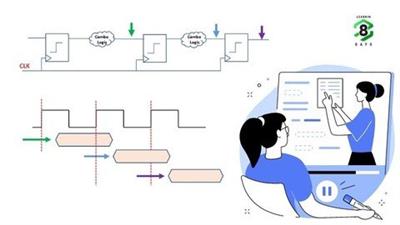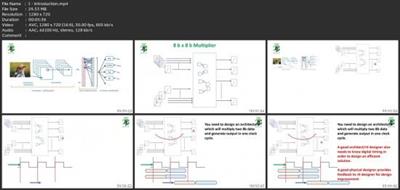- Thread Starter
- #1

Digital Timing Basics For Vlsi Interview & Soc Design
MP4 | Video: h264, 1280x720 | Audio: AAC, 44.1 KHz
Language: English (US) | Size: 826.03 MB | Duration: 4h 1m
A VLSI Course on Timing Concepts frequently used in Physical Design (Static Timing Analysis - STA), RTL & Circuit Design
MP4 | Video: h264, 1280x720 | Audio: AAC, 44.1 KHz
Language: English (US) | Size: 826.03 MB | Duration: 4h 1m
A VLSI Course on Timing Concepts frequently used in Physical Design (Static Timing Analysis - STA), RTL & Circuit Design
What you'll learn
Basics of Flop & Latch Timings
Set-up, Hold, Clock to Q, Clock Skew
Set-up & Hold violation checks
Set-up & Hold violation fixes
Latency Minimization
Set-up & Hold Margin in Digital Ckts
Min & Max Path Analysis
Clock Gating
F-V Curve in SoC
Requirements
Knowledge of Flop functionality will suffice
Description
A VLSI Course on Basic Timing Checks for Digital Logics - A MUST Course for VLSI students and professionals intended to work in Physical Design / Front-end (RTL) Design / Verification / Circuit Design.Understanding of Flop, Latch and Logic Gates timings (Set-up time, hold-time, Clock to Q delay) is very crucial for every VLSI designer. Whether you are working as Physical Designer (back-end) or RTL designer (front-end) or Verification engineer or Circuit Designer, Digital logics and associated timings form the basis of design performance in SoC design.Clock skew is another important factor in Static Timing Analysis. This course will cover most critical timing aspects of Flops and how set-up and hold margins are computed in Digital design. In addition, this course will provide insights to latency minimization, another crucial aspect of Physical Design.This is a MUST Course for every VLSI aspirants who aspire for a successful career in semiconductor industry. If you are preparing for VLSI interview or GATE exam, then this is right course for you.All the concepts taught in this lecture series are followed by relevant examples which will help students to get a full understanding of each concept. This is perfect course for VLSI interview preparation.This Crash Course is prepared by VLSI industry expert with inputs from Industry professionals working in companies such as Texas Instruments, AMD, Intel, Qualcomm, Rambus, Samsung etc.Concepts covered in this course are - Flop and Latch operation, Set-up time, Hold time, Clock to Q delay, Buffer, Clock Skew, Set-up Margin, Hold Margin, Cycle path analysis, Digital vs Physical implementation, Example of violations and fixing those violations, Latency minimization, Clock-Gating and Frequency-Voltage Curve in SoC.All the best for your VLSI journey!
Who this course is for
VLSI students,VLSI professionals,Electronics Engineer,Electrical Engineer,Physical Design Engineer,RTL Designer,Circuit Designer,Verification Engineer,SoC Designer

Download link
rapidgator.net:
You must reply in thread to view hidden text.
nitroflare.com:
You must reply in thread to view hidden text.
ddownload.com:
You must reply in thread to view hidden text.
1dl.net:
You must reply in thread to view hidden text.

